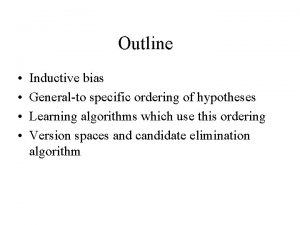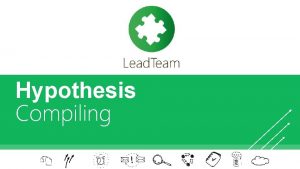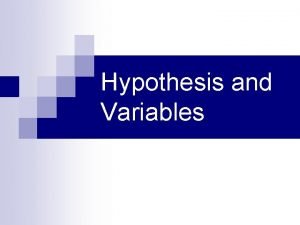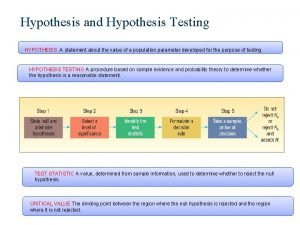Can Inductive Learning Work Inductive hypothesis h size








- Slides: 8

Can Inductive Learning Work? Inductive hypothesis h size m Training set D - + + + - + - that+ p(x): probability + from X example x is picked - + - Example set X + h: hypothesis that agrees with all examples in D L Hypothesis space H size |H|

Approximately Correct Hypothesis h H is approximately correct (AC) with accuracy e iff: Pr[h(x) correct] > 1 – e where x is an example picked with probability distribution p from X

PAC Learning Algorithm § A leaning algorithm L is Provably Approximately Correct (PAC) with confidence 1 -g iff the probability that it generates a non-AC hypothesis h is g: Pr[h is non-AC] g • Can L be PAC if the size m of the training set D is large enough? • If yes, how big should m be?

Intuition § If m is large enough and g H is not AC, it is unlikely that it agrees with all examples in the training dataset D § So, if m is large enough, there should be few non-AC hypotheses that agree with all examples in D § Hence, it is unlikely that L will pick one

Can L Be PAC? § Let g be an arbitrary hypothesis in H that is not approximately correct h H is AC iff: Pr[h(x) correct] > 1–e § Since g is not AC, we have: Pr[g(x) correct] 1–e § The probability that g is consistent with all the examples in D is at most (1 -e)m § The probability that there exists a non-AC hypothesis matching all examples in D is at most |H|(1 -e)m § Therefore, L is PAC if m verifies: |H|(1 -e)m g L is PAC if Pr[h is non-AC] g

Calculus § H = {h 1, h 2, …, h|H|} § Pr(hi is not-AC and agrees with D) (1 -e)m • Pr(h 1, or h 2, …, is not-AC and agrees with D) Si=1, …, |H|Pr(hi is not-AC and agrees with D) |H| (1 -e)m

Size of Training Set § From |H|(1 -e)m g we derive: m ln(g/|H|) / ln(1 -e) § Since e < -ln(1 -e) for 0 < e <1, we have: m ln(g/|H|) / (-e) m ln(|H|/g) / e § So, m increases logarithmically with the size of the hypothesis space But how big is |H|?

Importance of KIS Bias § If H is the set of all logical sentences nwith n observable predicates, then |H| = 22 , and m is exponential in n § If H is the set of all conjunctions of k << n observable predicates picked among n predicates, then |H| = O(nk) and m is logarithmic in n § Importance of choosing a “good” KIS bias















